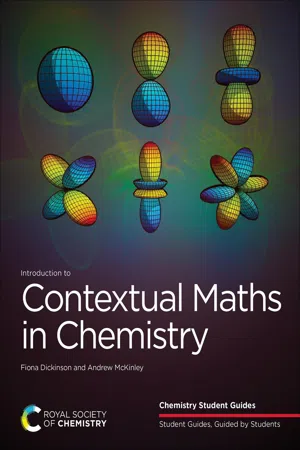
Introduction to Contextual Maths in Chemistry
Fiona Dickinson, Andrew McKinley
- 295 páginas
- English
- ePUB (apto para móviles)
- Disponible en iOS y Android
Introduction to Contextual Maths in Chemistry
Fiona Dickinson, Andrew McKinley
Información del libro
CHEMISTRY STUDENT GUIDES. GUIDED BY STUDENTS
For any student who has ever struggled with a mathematical understanding of chemistry, this book is for you.
Mathematics is the essential tool for physical scientists. We know that confidence in using mathematics early on in a chemistry degree builds a solid foundation for further study. However, applying the abstract mathematics taught in schools to chemical phenomena is one of the biggest challenges that chemistry students face.
In this book, we take a 'chemistry-first' approach. We link the mathematics to recognisable chemical concepts, building on high school chemistry, to facilitate deeper understanding. We cover the practical mathematical skills, including representation of data as tables and graphs, and give an overview of error handling in the physical sciences. More advanced mathematical concepts are introduced, using calculus to determine kinetic rate laws, intermolecular forces and in quantifying energetic change in thermodynamics. We also introduce the concept of the complex number and its role in considering quantum wave functions, widely used in computational chemistry.
There are worked examples and problem sets to provide plenty of practise material to build proficiency. We also include insights from real students, which identify common problem areas and provide the prompts that helped them to overcome these.
Chemistry Student Guides are written with current students involved at every stage, guiding the books towards the most challenging aspects of the topic.
Preguntas frecuentes
Información
CHAPTER

- □Notation of functions and inverse functions
- □Higher-order operations: powers, roots, exponentials and logarithms
- □Identifying inverse functions of higher-order operations
- □Strategies for using inverse functions to rearrange equations
- □Dimensional analysis: using units to validate equations and in combining quantities
- □SI base and derived units
- □Scaling factors: both SI and non-SI
- □Interconverting units and identifying a scaling factor
Why This Chapter Is Important
- There is a wealth of mathematical notation which we need to understand to apply the maths in a chemical context.
- The models we use in chemistry are fundamentally mathematical; understanding the mathematical relationships allows us to apply these ideas.
- All these models are represented as equations; being able to rearrange and manipulate them allows us to make predictions and to interpret experimental observations.
- Values are meaningless without a unit; having a consistent and systematic approach to the handling of units means that values can be shared and interpreted with no ambiguity, whether using SI units or quantities which are more manageable in a chemistry context, including dm3 and wavenumbers (cm−1).
- The process of dimensional analysis allows us to determine the appropriate units for our calculated quantities.
